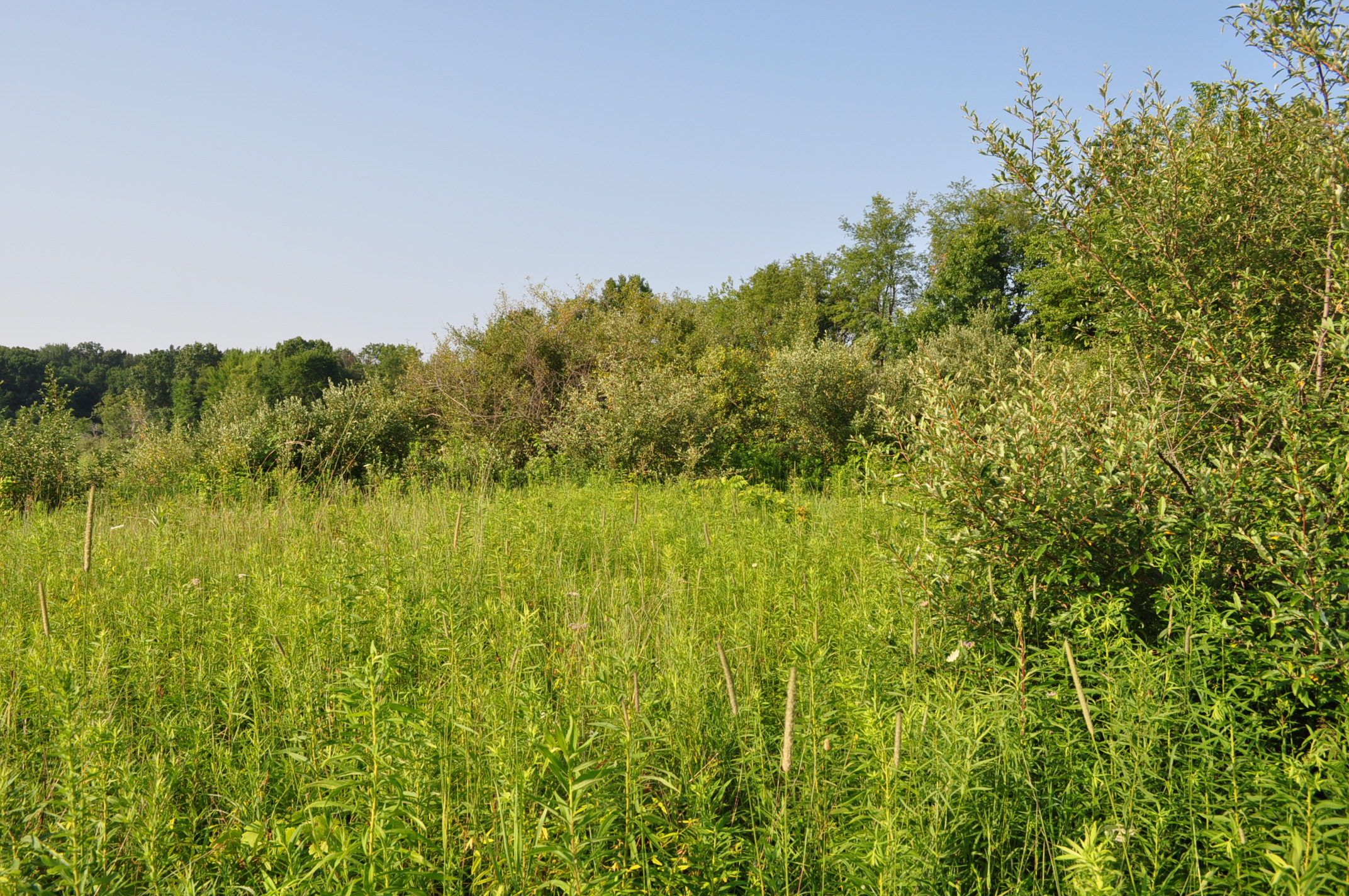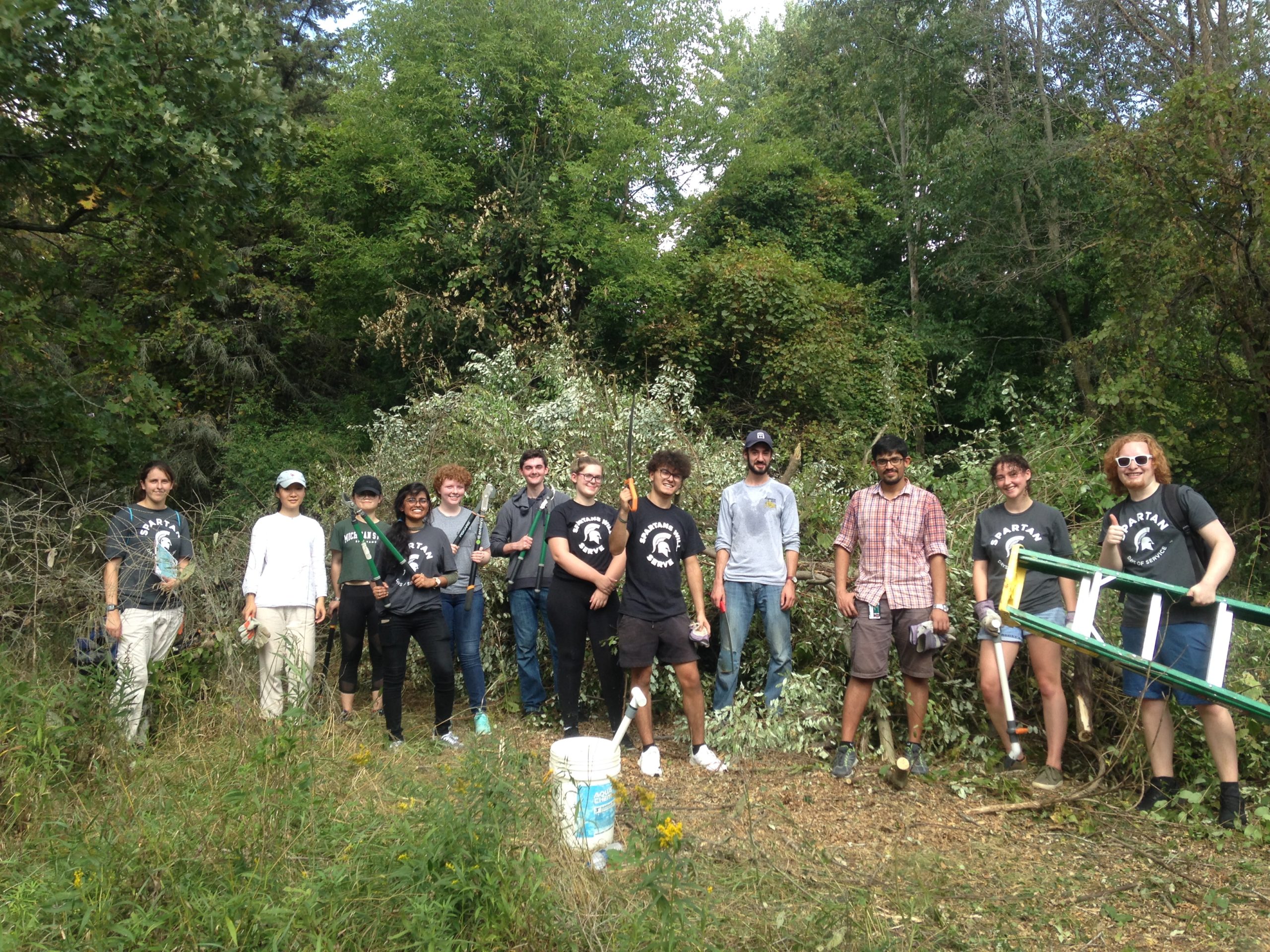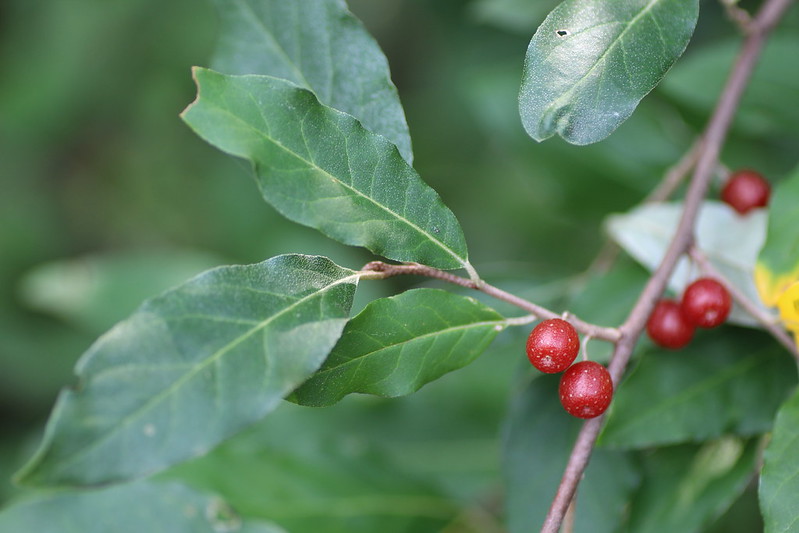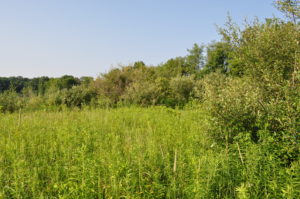
Autumn olive at Bernard W. Baker Sanctuary (2014), pre-restoration and removal of autumn olive stands to improve grassland habitat.
As summer peaks and wanes into the fall, Michigan Audubon staff and volunteers shift our focus to controlling woody invasive plants at Michigan Audubon sanctuaries. Earlier in the summer (and spring), our focus was on herbaceous weeds like garlic mustard and dame’s rocket. One of the woody plants we focus on during this time of year (later summer through fall and winter) is autumn olive (Elaeagnus umbellata). Autumn olive is a tall deciduous shrub or small tree and can reach heights of up to 20 feet (6 meters).
Introduced to the U.S. in the 1830s and originating in Asia, this tall shrub was planted frequently as a beneficial berry-producing plant for birds and other wildlife (until its invasive habits were recognized). What makes autumn olive particularly invasive? It’s quick to grow and spread, it is not easy to eradicate from an area, and it can outcompete native plants (through its fast growth and tolerance to deer browsing). Autumn olive also degrades habitat such as prairies or barrens for native plants that have adapted to low-nutrient growing conditions, because autumn olive is able to fix nitrogen in the soil.
Unfortunately, hindsight is 20:20. Autumn olive as an introduced plant is one example where the unknown consequences far outweigh the original altruistic intent behind its introduction as a beneficial wildlife plant. From about the 1940s to the 1970s, conservation districts offered a prolific berry-producing variety of autumn olive through their spring plant sales, knowing that the shrub served as wildlife food, windbreaks, and soil stabilization, and grew in a wide variety of conditions. Today, with a better understanding of invasive species and the growth habits of autumn olive, conservationists are working hard to rid natural areas of this plant.
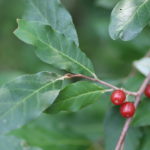
Autumn olive, Eleagnus umbellata. CC Corey Raimond.
How To Identify
Autumn olive is a tall upright shrub that can grow into a small tree size (up to about 20 feet tall). Its leaves are distinctly silvery on the undersides, and upon closer look, the leaves are covered in tiny dots or stipules. The berries, when ripe, are a bright red with silvery scales or dots. Watch out for thorns! Thorns are found on some, but not all, autumn olive bushes, and from personal experience, they hurt if you grab onto the wrong place when removing an autumn olive bush!
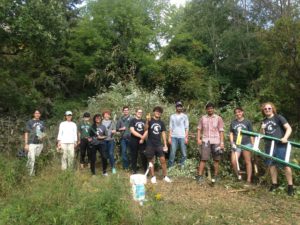
A group of MSU student volunteers in September 2019, help remove a stand of autumn olive at Capital City Bird Sanctuary. Photo: L. Rowse
What To Do
Autumn olive may be controlled with herbicide and through regular maintenance of habitat such as prescribed burning in prairies or regular mowing. All management activities must be considered carefully in order to not disturb nesting birds, threatened species like Eastern massasauga rattlesnakes, and to not disrupt native plant growing conditions even further.
If your control method is to simply cut back or mow the autumn olive stems, however, this only serves to prune and stimulate the shrub’s growth. Even when controlled with a brush specific herbicide, keep an eye out in the next seasons of growth for new autumn olive bushes — where there was one previously producing berries, new shrubs will grow.
Learn More!
- Learn more about identification of autumn olive and what you can do to reduce its spread: https://www.michigan.gov/documents/dnr/Autumn_Olive_389111_7.pdf
- The Midwest Invasive Species Information Network has an excellent online learning module about autumn olive: https://www.misin.msu.edu/train/species/Autumnolive/story_html5.html
- A detailed and helpful invasive plant identification guide, from Michigan Natural Features Inventory: https://mnfi.anr.msu.edu/invasive-species/InvasivePlantsFieldGuide.pdf
- Woody Invasives of the Great Lakes – a comprehensive guide and resource for invasive plants: https://woodyinvasives.org/woody-invasive-species/autumn-olive/
Reminder: What Makes a Plant Invasive?
As defined in the National Invasive Species Management Plan, an invasive species is “a species that is non-native to the ecosystem under consideration and whose introduction causes or is likely to cause economic or environmental harm or harm to human health.”
What does this definition mean to you? Perhaps consider these factors when thinking about whether a plant, insect, or other animal is invasive or not:
- Is it from Michigan originally, for example, prior to European settlement of Michigan?
- Does it spread or reproduce rapidly?
- Is it harmful to native species? Does it outcompete native plants or animals? Is it edible by native insects/wildlife/birds?
Volunteer Opportunities
Sign up for Michigan Audubon’s eNewsletter for more information on upcoming volunteer days at Michigan Audubon sanctuaries!

